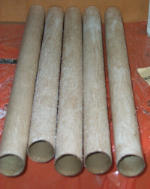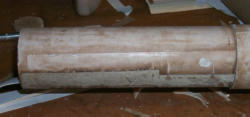Scratch StarScraper Original Design / Scratch Built
Scratch - StarScraper {Scratch}
Contributed by Brian Mardirosain
| Manufacturer: | Scratch |
 Introduction:
Introduction:
Always wanted a Mean Machine when I was a kid,
but never got around to getting one. When I raided the house recycling bin in
January, I discovered five identical wrapping paper tubes. Being on the flimsy
side, figured it would be a test to reinforce them enough to fly on a G motor
in the form of a super roc.
Nose Cone:
 Shaped out of a
styrofoam ball used for a Christmas decoration that had seen better days. Hmm,
have to say the same thing about the nose cone.
Shaped out of a
styrofoam ball used for a Christmas decoration that had seen better days. Hmm,
have to say the same thing about the nose cone.
Recovery System:
A parachute that I had created for
Little
Guy that was way too big for that model and a bit small for this one was
pressed into service. It then dawned on me that long body-tubed rockets have
airframes that try to pretend they are gliders on the way down.
Body Tubes:
 I first wrapped the
tubes with a layer of craft paper and wood glue. Once that set-up, I then
applied one layer of copy paper and wood glue. When everything dried, I was
amazed with the amount of strength added to the tubes. They went from being
easily bent with slight pressure to being at least twice as strong as Estes
tubing. I was also pleased with the fact that the tubes remained fairly
lightweight, certainly lighter than some heavy-duty tubes of similar size used
in fabric rolls. Overall, a worthy compromise in strength-to-weight ratio, and
you can't beat the price.
I first wrapped the
tubes with a layer of craft paper and wood glue. Once that set-up, I then
applied one layer of copy paper and wood glue. When everything dried, I was
amazed with the amount of strength added to the tubes. They went from being
easily bent with slight pressure to being at least twice as strong as Estes
tubing. I was also pleased with the fact that the tubes remained fairly
lightweight, certainly lighter than some heavy-duty tubes of similar size used
in fabric rolls. Overall, a worthy compromise in strength-to-weight ratio, and
you can't beat the price.
Motor Mount Tube:
Nothing all that exciting to report on, basic two
centering rings of 1/8 balsa with a slightly oversized motor mount tube of
thick cardboard tubing from what I believe was the core of a fax machine paper
roll.
Fins:
Again, nothing all that exciting to report. I
moved the fins 3" away from the bottom since the super roc design in
inherently over stable, and I wanted to give them some protection from fast
landings.
Couplers
 I heard it
time and time again from others more wise than I that couplers makes or breaks
(literally) a super roc. 13" coupler for the mid-body separation point,
with 6" couplers used in the three other joints. Since I used a tube of
the same diameter as the rest, I needed to somehow reduce the circumference of
it. Instead of doing it the right way, I just overlapped the material and
filled in the rest with a scrap piece and sanded a bit. It worked, and I didn't
have to risk the chance of ruining a coupler.
I heard it
time and time again from others more wise than I that couplers makes or breaks
(literally) a super roc. 13" coupler for the mid-body separation point,
with 6" couplers used in the three other joints. Since I used a tube of
the same diameter as the rest, I needed to somehow reduce the circumference of
it. Instead of doing it the right way, I just overlapped the material and
filled in the rest with a scrap piece and sanded a bit. It worked, and I didn't
have to risk the chance of ruining a coupler.
Launch Lugs:
I tried my old 1/4" screw eye-in-balsa
method, which can be seen on the
VSOS2
page. One of them promptly ripped out when the rocket was on the pad. A larger
set of lugs were needed. I ended up using 1/2" peg-board thingies. Tough
to explain without a picture (it is coming). Two 1/2" circles of the
atypical metal used for peg board hooks, attached via a vertical piece of metal
of the same diameter. Spanning horizontally across this piece is a crossbar
with a hook on either side that attaches to the peg board. With a little work,
I was able to sink the connective material flush with the surface of the balsa
blocks on the rocket, with the peg board hooks resting on the surface of the
rocket itself. A little 5 minute epoxy in the appropriate places, and I had me
an impressive set of launch lugs. They worked great!
Painting:
Grabbed what I had on the shelf and went to work,
just one layer of each. If I were to do it over again, I wouldn't have used
black. Didn't think such a small area would be affected so much by the sun, but
it is.
First Flight:
After the launch lug issue at the first
CMASS launch of the season, I was able to
finally get this bird into the air on 07/23/00. Taking advantage of a calm
spell, Star Scraper rose without incident up a G38-4. Unfortunately, at about 2
seconds after burn-out ejection occurred. No damage to report, but I'd say the
rocket was only 400' off the ground, tough to say since it is so tall. All of
the kids were pointing and commenting on it, and some of the adults had some
snide comments about it, tehehe. It certainly is a looker, and it towered above
the Mean Machine that was also flying that day.
Conclusion:
It took a long time to finish from beginning to
end, but it was worth it. Certainly an attention-getter (134"x2.25"),
and it proves that paper and wood glue can significantly add strength with
little weight to body tubes.
Sponsored Ads
 |
 |











